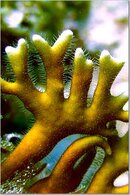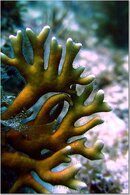FC comes in many shapes, sizes and colors. A simple yahoo or google of fire coral pictures, then click on more fire coral images next to the 4 thumbs (yahoo). I went 5 pages through different kinds of FC before finding shots of the orange/brown/red I remembered from the Florida Keys.
There have been a few TV news stories here about the Hawaii University Coral Research, and every video clip shows bare handed workers/researchers with some local hard corals. That does not mean all local hard corals react the same. Luckily/unfortunately there are usually plenty of dead spots, perhaps more poluted runoff damage than diver contact, so an occassional finger can easily do no damage to coral.
Saw some Discovery Channel footage of white tip reef sharks hunting at night, talk about your coral damage! Schooling parrotfish(!?); a couple of my favorite elkhorn corals have every end chomped by 2 or more inches. Coral is tough, it survives a lot, but we should not add to the stress. Do the right thing for the right reason.
These shrimp are hoping humans will open their mouths, just like every other predator who visits them;
Teeth Cleaning!

Notice dead coral contact above.
Molars?

Tonsils??!!

Note to self; pay more attention to BCD/Inflator when shrimp goes deep throat!
There have been a few TV news stories here about the Hawaii University Coral Research, and every video clip shows bare handed workers/researchers with some local hard corals. That does not mean all local hard corals react the same. Luckily/unfortunately there are usually plenty of dead spots, perhaps more poluted runoff damage than diver contact, so an occassional finger can easily do no damage to coral.
Saw some Discovery Channel footage of white tip reef sharks hunting at night, talk about your coral damage! Schooling parrotfish(!?); a couple of my favorite elkhorn corals have every end chomped by 2 or more inches. Coral is tough, it survives a lot, but we should not add to the stress. Do the right thing for the right reason.
Matt S.:Cleaner shrimp are pretty safe to interact with though.
These shrimp are hoping humans will open their mouths, just like every other predator who visits them;
Teeth Cleaning!

Notice dead coral contact above.
Molars?

Tonsils??!!

Note to self; pay more attention to BCD/Inflator when shrimp goes deep throat!







